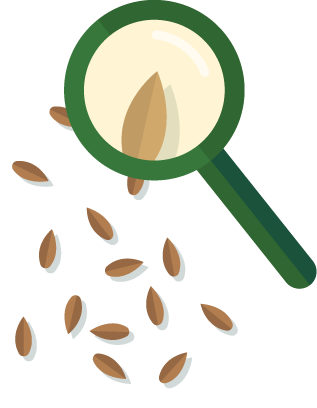
Whole rye is a whole grain cereal with a robust, slightly nutty flavour and a chewy texture. It is a staple in Northern and Eastern European cuisines, frequently used in bread-making, porridge, and as a grain in salads and side dishes. It works also well with cabbage, beets, mustard, raisins, and sweet and sour flavours.

Nutritionally, whole rye bread is high in fibre and a source of magnesium, phosphorus, iron, and copper. It also contains compounds like lignans, which have antioxidant properties. Whole rye is gluten-containing, which should be noted by those with gluten intolerance or coeliac disease.
The fibre in whole rye includes both soluble and insoluble types, which aid in digestion, help maintain healthy cholesterol levels, can improve gut health, and support blood sugar control. Lignans found in rye have also been associated with reduced risks of heart disease and certain cancers.

Toggle with the tables below to compare their nutritional content per 100 g (both cooked and uncooked) and per average portion size. You might be surprised by the differences!
| Grains | Kcal | Protein | Fat | Saturated fat | Carbohydrates | Fibre |
|---|---|---|---|---|---|---|
| Wholemeal rye bread, Per 100 g, cooked | 193.00 | 5 | 1 | 0 | 35 | 8 |
Whole grains are all packed with carbohydrates and dietary fibre (which is a type of carbohydrate) and are naturally low in (saturated) fat. Fibre is important for our health and the prevention of many chronic diseases. That’s why the European Food Safety Authority (EFSA) recommends we eat at least 25 g of fibre per day. Sometimes, you might see whole grains labelled as ‘high in fibre’ or ‘source of fibre’ – but what does that really mean?
| Grains (% of DRV) | Calcium | Magnesium | Phosphorus | Potassium | Iron | Zinc | Copper | Vit. B1 | Vit. B2 | Vit. B3 | Vit. B6 | Folate |
|---|---|---|---|---|---|---|---|---|---|---|---|---|
| Wholemeal rye bread, per 100 g, cooked | 4.13 | 15.20 | 24.86 | 12.05 | 19.29 | 15.00 | 18.00 | 5.45 | 4.29 | 6.88 | 14.29 | 9.12 |
| Wholemeal rye bread, per portion, cooked | 1.44 | 5.32 | 8.70 | 4.22 | 6.75 | 5.25 | 6.30 | 1.91 | 1.50 | 2.41 | 5.00 | 3.19 |
% of DRV stands for dietary reference value. DRV stands for dietary reference value. These values estimate how much of a nutrient most healthy people in Europe need each day. Ideally, we should aim to reach 100% of these values daily. Each vitamin and mineral has their own DRV, as set by EFSA.
You might have heard that whole grains are ‘high in,’ ‘rich in,’ or ‘source of’ a certain vitamin or mineral. These term are regulated by EFSA and products must meet specific rules to be considered as such. Here’s how to interpret these contributions:

Store in an airtight container in a cool, dry place. Follow the instructions on the packaging to keep the food good for as long as possible.
Whole rye has a best-before date, meaning that it can often be eaten after that date has passed. If they look, smell and taste good, and the packaging is also intact, it will most likely be safe.

Follow the instructions on the packaging to cook rye. Cooking times can vary depending on the variety and type of rye.
As a general rule of thumb, to cook whole rye, rinse it in a fine-mesh strainer. Then, add 1 part of whole rye to 3 parts of water or broth in a pot. Bring to a boil, then reduce heat, cover, and simmer for 45-60 minutes, until the rye is tender, and the liquid is absorbed. Fluff with a fork before serving.

Refined rye products, such as white rye flour or rye bread made with refined rye flour, are not whole grain. Whole grain rye retains its bran and germ, which are removed in refined rye products, leading to a loss of nutrients like fibre and essential vitamins.
Learn to identify whole grain products, cook delicious meals, find practical tips for a smooth, gradual switch, and much more!